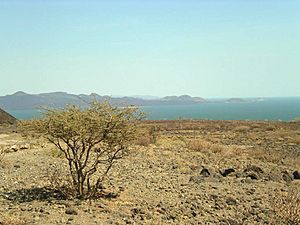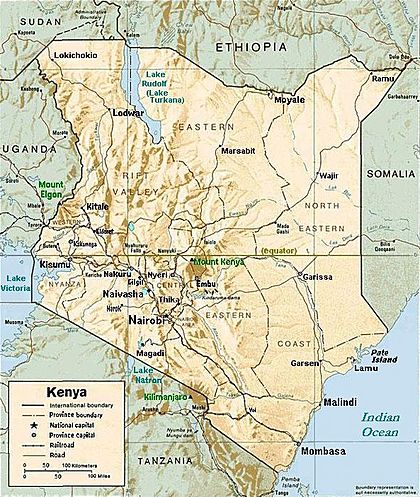Lake Turkana facts for kids
Quick facts for kids Lake TurkanaJade Sea |
|
|---|---|
 |
|
| Coordinates | 3°35′N 36°7′E / 3.583°N 36.117°E |
| Type | Saline, monomictic, alkaline, endorheic |
| Primary inflows | Omo River, Turkwel River, Kerio River |
| Primary outflows | Evaporation |
| Catchment area | 130,860 km² |
| Basin countries | Ethiopia, Kenya |
| Max. length | 290 km |
| Max. width | 32 km (20 mi) |
| Surface area | 6,405 km2 (2,473 sq mi) |
| Average depth | 30.2 m |
| Max. depth | 109 m |
| Water volume | 203.6 km³ |
| Surface elevation | 360.4 m |
Lake Turkana, also called the Jade Sea, is a large lake in northwest Kenya. It is part of the Great Rift Valley. A small part of its northern end reaches into Ethiopia.
This lake is special because it is the world's biggest permanent lake in a desert. It is also the largest alkaline lake on Earth. By how much water it holds, it's the fourth largest salt lake in the world. Only the Caspian Sea, Issyk-Kul Lake, and the shrinking Aral Sea are bigger.
The water in Lake Turkana is safe to drink, but it doesn't taste very good. Even so, it is home to many different kinds of wildlife that live in lakes. The area around the lake is very hot and dry.
Lake Turkana: A Volcanic Wonderland
The land around Lake Turkana is mostly made of volcanic rocks. This means it was formed by volcanoes long ago.
Active Volcanoes and Rocky Shores
Central Island in the middle of the lake is an active volcano. It still lets out steam and gases. The eastern and southern sides of the lake have rocky shores and outcrops (places where rocks stick out of the ground). The western and northern sides are lower and have sand dunes and flat areas.
Strong Winds and Water Levels
The lake warms up and cools down slower than the land around it. This can cause very strong winds both on and off the shore. Sudden, powerful storms are common here.
Three rivers flow into the lake: the Omo River, Turkwel River, and Kerio River. But no rivers flow out of Lake Turkana. The only way it loses water is through evaporation (when water turns into vapor and goes into the air). Because of this, the lake's size and water level can change a lot. For example, its level dropped by 10 meters between 1975 and 1993.
Wildlife and Natural Hazards
Lake Turkana is a wild and untouched place. This is because it is very hot, dry, and hard to reach.
Animals of Lake Turkana
Many Nile crocodiles live on the flat areas around the lake. The rocky shores are home to scorpions and carpet vipers. These are venomous snakes.
Staying Safe at the Lake
Many people visit Lake Turkana on expeditions with guides and park rangers. They help visitors explore safely. However, it can be dangerous for tourists who visit without experienced guides.
Protected Areas and Ancient Discoveries
Lake Turkana is so important that parts of it are protected.
National Parks and World Heritage Sites
The Lake Turkana National Parks are a UNESCO World Heritage Site. This means they are recognized as very important places for everyone in the world.
- Sibiloi National Park is on the eastern shore of the lake.
- Central Island National Park and South Island National Park are islands within the lake.
Both of these parks are known for their many crocodiles.
Cradle of Humankind
Many anthropologists (scientists who study human history and culture) believe the Lake Turkana area is where humans first began. This is because many hominid fossils have been found here. Hominids are early human ancestors. In 1984, the skeleton of a very important fossil called Turkana boy was found near the lake.
Images for kids
-
View of Lake Turkana with the Koobi Fora formations in the background.
See also
 In Spanish: Lago Turkana para niños
In Spanish: Lago Turkana para niños





